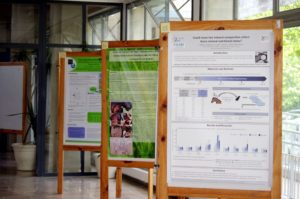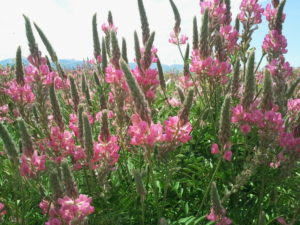Report on the European Workshop on Equine Nutrition (EWEN): Part 2
Founder of MB Equine Services, Mariette van den Berg, travelled in June to Europe to attend two very special equine science conferences – the European Workshop on Equine Nutrition (EWEN) and the International Society for Equitation Science (ISES) Conference.
 At both of these conferences, Mariette presented results from her PhD project that focuses on behavioural mechanisms of diet selection by horses. In this series, she features a selection of interesting topics and findings from her own project, and other researchers who attended the 8th bi-annual EWEN, which was held in Dijon, France.
At both of these conferences, Mariette presented results from her PhD project that focuses on behavioural mechanisms of diet selection by horses. In this series, she features a selection of interesting topics and findings from her own project, and other researchers who attended the 8th bi-annual EWEN, which was held in Dijon, France.
EWEN is recognised as Europe’s leading scientific event in equine nutrition, and brings European and international scientists together to share scientific information, disseminate technical expertise amongst the wider horse industry and foster innovation.
In this, Part Two of her report, she presents a summary of a study that investigated whether plant secondary compounds and additional protein in the diet could help control strongyle infections.
2. Researchers investigate alternative worm control
Due to the alarming spread of worms that have developed a resistance to current anthelmitic drugs and the lack of new drugs being developed, research teams around the world have been looking for alternative treatments.
A French research group examined the use of secondary plant compounds (condensed tannins) and extra protein in the diet of horses as an alternative to control strongyle (redworms) infections. In earlier articles on pasture diversity, and fodder trees and shrubs for horses, I have written about the benefits of plant secondary compounds, and it is great to see more research is being done on this subject.
Plant secondary compounds are complex chemicals made by plants that are not normally essential to the life of the plant. They are thought to be produced for the plant’s protection, for example as pesticides and anti-grazing agents, but they also include pigments, hormones and chemical agents that can attack other plants (alleleopathy).
The French presentation was titled: Sainfoin (Onobrychis viciifolia) or extra proteins in the diets as an alternative to control horse strongyle infections? (G. Fleurance et al.).
Anthelmintic resistance of equine strongyle nematodes to regular wormers has become a major problem worldwide and has created an urgent need for more alternative strongyle control.
In ruminants, it has been suggested that extra protein (improved feed complementation) could help animals compensate for the parasite burden, especially if diets are protein-limiting, and the use of bioactive forages, like sainfoin, which contains plant secondary compounds (condensed tannins), have been proven to have anthelmintic effects in several studies in small ruminants (Houdijk et al. 2000, Brunet et al. 2007).
In equines, only two in vitro (in the lab, rather than in horses) studies have been conducted that investigated the influence of different plant extracts and demonstrated a significant effect against strongyle for a number of them (Payne et al. 2013, Peachey at al. 2015). Therefore, the aim of this study was 1) to evaluate the efficiency of a short-term consumption of either extra protein or sainfoin by horses to reduce faecal egg excretion in naturally-infected horses and, 2) to investigate the influence of secondary compound of sainfoin on strongyle egg hatching and larval development in vivo (in horses).
The experiment was conducted at an experimental farm of the French Horse and Riding Institute in Chamberet, France, over a period of 17 days in 2013. The researchers used 30 horses that were divided into three groups of 10 individuals.

Group one received a tannin-rich diet (SD), with 70% dry matter (DM) sainfoin pellets (which would contain 3.6% DM condensed tannins). Group two was offered a protein-rich diet (PD), with 52% DM Italian rye-grass pellets and 10% DM grinded linseed expeller. Group three received a control diet (CD) with 45% DM barley and 25%DM cereal-based pellets. All groups were given 30% wheat straw.
The diets were all similar in energy intake, covering an average of 94% of energy requirements. SD and PD diets provided extra protein – about 227% of protein requirements vs. 93% for CD diet. The researchers compared PD and CD to test for benefits of extra protein, while SD and PD were compared to examine the effect of the sainfoin secondary compound.
Faecal egg counts (FEC) were individually measured on four dates (horse grouping, adaptation period, and start and end of experiment). They also investigated larvae development (L3) by incubating (pooled) faecal samples and they performed two in vitro experiments; a larvae development assay with rehydrated sainfoin at different rates (0-29%), which was added to faeces of infected horses (6 replicates) and an egg-hatching assay, which involved adding sainfoin solutions at different concentrations to strongyle eggs solutions (5 replicates).
While this study reported that overall FEC decreased over time, there was no significant effect of diet or diet x sampling time interaction. In addition, they did not report the baseline FEC levels per group, so it is difficult to assess if there were any differences within groups.
However, at group level, the authors did observe a lower rate of strongyle larval development in the SD group at the end (SD: 8%, PD 30.5% and CD: 22.6%), but they were not able to perform any further analysis to determine if this difference was significant, as they had no replicates.
Nevertheless, they were able to confirm that adding 29% sainfoin pellets to the faeces (manure) significantly reduced strongyle egg development into larvae (L3) – by 82% – and a solution with sainfoin concentrations of 7.5 mg/ml or higher significantly reduced egg hatching – by 36%.
These findings suggest adverse effects of sainfoin on larvae development, but more in vivo work needs to be conducted to replicate the results for the larvae development, as well as for the effect on FEC when the sainfoin is added to the diet.
It is also not clear if the extra protein had an effect in this study, so they suggest more work needs to be done with more protein-limiting diets. Nevertheless, this study suggests that short-term use of sainfoin in horse diets could be a promising strategy to reduce risk of infection by strongyles at pasture.
If you are interested in more information about this topic, check out the Australian paper by Payne et al. 2013 ‘Australian plants show anthelmintic activity toward equine cyathostomins in vitro’, which you can read here.
References:
- Brunet, S., Aufrere, J., El Babili, F., Fouraste, I., & Hoste, H. (2007). The kinetics of exsheathment of infective nematode larvae is disturbed in the presence of a tannin-rich plant extract (sainfoin) both in vitro and in vivo. Parasitology, 134(09), 1253-1262.
- Houdijk, J. G. M., Kyriazakis, I., Jackson, F., Huntley, J. F., & Coop, R. L. (2000). Can an increased intake of metabolizable protein affect the periparturient relaxation in immunity against Teladorsagia circumcincta in sheep?. Veterinary Parasitology, 91(1), 43-62.
- Payne, S. E., Kotze, A. C., Durmic, Z., & Vercoe, P. E. (2013). Australian plants show anthelmintic activity toward equine cyathostomins in vitro. Veterinary parasitology, 196(1), 153-160.
- Peachey, L. E., Pinchbeck, G. L., Matthews, J. B., Burden, F. A., Mulugeta, G., Scantlebury, C. E., & Hodgkinson, J. E. (2015). An evidence-based approach to the evaluation of ethnoveterinary medicines against strongyle nematodes of equids. Veterinary parasitology, 210(1), 40-52.


Follow Us!